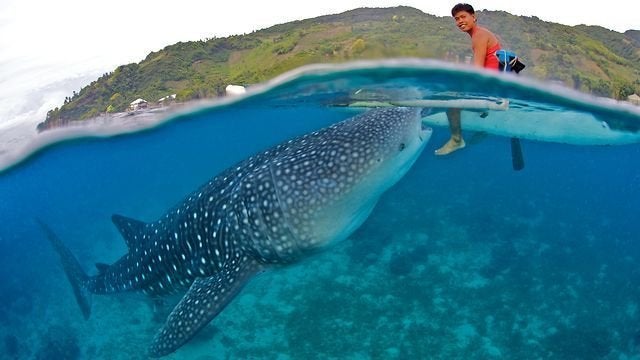
Last year, fishermen from the tiny Philippine town of Oslob got very famous very fast.
A small group of men, who made a meager living catching fish from their outrigger canoes, started doing something no one else in the world had done, hand feeding the world's largest fish, the whale shark, in the open ocean. The sharks seemed to like it.
Word spread, first among Filipinos, and then internationally as the fishermen began taking paying passengers with them. Less than a year later, an international tourism boom has engulfed Oslob, and along with it, a boisterous debate is stirring between environmentalists, tourism officials and the fishermen--now called "Whale Shark Feeders"--who started it all.
"There's no place else in the world where people are feeding whale sharks like this," said Anna Lucey, a researcher working with LAMAVE, an Italian environmental organization studying the whale sharks in Oslob. "It's an amazing opportunity to interact so closely with the sharks, but it also raises serious questions about the impact on their behavior, diet, and migration patterns."
This new development, according to local tourism authorities, is good news for the endangered whale sharks. The fishermen and the sharks were in competition over the same territory -- one group hunted for small krill (the sharks' preferred food) prevalent in the area, the other for the larger fish found in surrounding waters. When a whale shark would venture into their territory, the fishermen caught fewer fish. Something had to be done.
Instead of killing these massive creatures and selling their fins, as often happens in other parts of the world, the fishermen figured out a better way. Each day, one of them would lure the whale sharks out of the fishing area by dropping a trail of small shrimp into the water while his colleagues continued their work. Perfecting the practice, the Feeders now lead the sharks into the throngs of awaiting tourists, some of whom watch from small boats while others snorkel, which sometimes leads to inadvertent contact with the fish themselves (contact and touching is officially prohibited, though it can and does happen).
"It's pretty unreal to experience in person, but it just doesn't seem like it could be a good thing for the sharks," a Canadian visitor told me while in Oslob. "Of course, the folks at Sea World have taught killer whales to jump through hoops, so I guess this isn't so bad."
The debate about this unique practice is deepening, but an initial semblance of order seems to be surfacing in and out of the water, as evidenced from a new set of local government guidelines that took effect the day my wife Liz and I arrived in April.
The most controversial change was the price, which tripled overnight for foreigners to 500 pesos (about $12) to view the feedings from a boat and 1000 pesos (about $25) to swim with and take photos of the sharks. Filipinos pay about half that.
Some say it's too much of an increase. Others say not enough. Everyone wonders how all the new money will be spent. There's also a movement underway to establish minimum distances snorkelers must keep away from the sharks and to limit the number of visitors and boats, which tourism officials say should be at least partially addressed by the increase in fees. And of course, floating just above the drama around costs and tourism is the bigger question of whether humans should be feeding these incredible fish at all.
In the meantime, tourists continue venturing by the busload to the remote town of Oslob. They join the tours, swim with the sharks and watch in wonder as The Whale Shark Feeders drop tiny shrimp into the gaping mouths of the world's largest fish.
HOW TO GET THERE: Oslob is on the Philippine island of Cebu, where you'll need to fly to Cebu City (Mactan-Cebu International Airport). From there you can either hire a private car for around $75 one way or head to the Cebu South bus terminal. Find the buses making the four-to-five hour trip south along the coast. Make sure to tell the driver to drop you at Oslob, as there's no bus station.
HOTELS: Accommodation is rustic and somewhat limited, though that's changing quickly. At least two small hotels were under construction during our visit, and others are planned. We stayed at MB Sunrise, which was the option closest to the whale shark viewing area and includes a small balcony overlooking the ocean. Rooms with shared bath, thin walls, and fan cost 800 pesos (about $20). A more comfortable option is to stay further down the coast in Lilo-An or Santander, which have more upscale options and from where you should be able to arrange day trips.
FOOD: Options are limited. Some of the hotels offer basic meals. There is a small town center in Oslob a few kilometers north and reachable by the three-wheeled motorcycles that serve as taxis.